There’s something magical about starting your day with a stack of warm, fluffy gluten-free pancakes. Whether it’s a lazy Sunday morning or a quick weekday bite, breakfast should always feel special. Over the years, traditional recipes have evolved to include options that cater to different dietary needs, making it easier than ever to enjoy your favorites without compromise.
Creating the perfect stack of gluten-free pancakes begins with the right ingredients. A flour blend that includes xanthan gum ensures the batter holds together beautifully. Add in essentials like eggs, milk, and a touch of baking powder, and you’re on your way to a golden brown finish that’s both light and satisfying.
This guide will walk you through every step, from measuring your flour correctly to flipping your batter onto a hot griddle. With tips inspired by classic recipes and modern techniques, you’ll master the art of making gluten-free pancakes that are as delicious as they are simple.
Introduction to Gluten Free Pancakes
Start your morning right with a plate of warm, homemade goodness. More people are turning to DIY recipes for their breakfast favorites, and for good reason. Homemade options are not only cost-effective but also allow you to control the quality of every ingredient.
Say goodbye to expensive boxed mixes. With a few pantry staples like xanthan gum and a reliable flour blend, you can whip up a batch of fluffy treats in no time. These recipes are versatile, letting you customize them to suit your taste or dietary needs.
One of the best parts? You likely already have everything you need in your kitchen. Eggs, milk, and a touch of baking powder are all it takes to create a golden brown stack that’s both light and satisfying. Plus, resting the batter for a few minutes ensures the perfect texture.
This guide will walk you through every step, from mixing the right way to cooking on a hot griddle. You’ll also discover creative mix-ins and toppings to make your breakfast even more special. Ready to elevate your mornings? Let’s get started.
Understanding Gluten Free Pancakes
Exploring the world of alternative breakfast options can open up a world of flavor and health benefits. These recipes replace traditional ingredients with alternatives that cater to specific dietary needs, ensuring everyone can enjoy a delicious start to their day.
What Are Alternative Gluten Free Pancake Recipes?
Alternative recipes use ingredients like flour blends made from rice, almond, or oat flour instead of wheat. These blends often include xanthan gum, a binder that mimics the texture of gluten. This ensures your batter holds together and cooks evenly.
Key components like eggs, milk, and baking powder remain essential. However, these recipes can be adapted for dairy-free or egg-free diets by using substitutes like almond milk or flaxseed. The result is a stack of golden brown treats that are both fluffy and satisfying.
Benefits of Choosing Gluten Free Pancake Recipes
Opting for alternative recipes offers several advantages. Improved digestibility is a major benefit, especially for those with sensitivities. These recipes also allow for greater customization, letting you tailor them to your preferences or dietary restrictions.
Understanding the role of each ingredient is crucial. For example, xanthan gum ensures the batter has the right consistency, while resting it for a few minutes before cooking enhances the texture. This knowledge helps you achieve perfect results every time.
| Ingredient | Role |
|---|---|
| Flour Blend | Replaces wheat flour for a gluten-free option |
| Xanthan Gum | Acts as a binder for proper texture |
| Baking Powder | Helps the batter rise and become fluffy |
| Eggs | Provides structure and moisture |
| Milk | Adds richness and smoothness to the batter |
By mastering these basics, you’ll be ready to create delicious breakfast options that everyone can enjoy. Whether you’re cooking on a griddle or experimenting with toppings, the possibilities are endless.
Essential Ingredients for Gluten Free Pancakes
Crafting the perfect breakfast starts with understanding the key ingredients. The right components ensure your stack is fluffy, light, and satisfying. Let’s dive into the essentials that make this possible.
Gluten Free Flour Blends and Their Role in Pancake Texture
Not all flours are created equal. A flour blend is essential for achieving the right texture. These blends often combine rice, almond, or oat flour to mimic the properties of wheat. Popular options like Pillsbury, King Arthur Measure-for-Measure, and Bob’s Red Mill are trusted for their consistency.
Using a blend ensures your batter holds together and cooks evenly. Single flours, like almond or coconut, can result in a dense or gritty texture. A blend balances the flavors and textures, giving you a light and airy result.
The Function of Xanthan Gum in Gluten Free Pancake Batter
Xanthan gum is a critical ingredient in gluten-free recipes. It acts as a binder, replacing the elasticity that gluten provides. Without it, your batter may fall apart or cook unevenly.
Most recipes recommend adding 1/4 teaspoon of xanthan gum per cup of flour. However, some blends already include it, so always check the label. Adjusting this ingredient ensures your pancakes have the perfect structure.
| Ingredient | Purpose |
|---|---|
| Flour Blend | Provides structure and texture |
| Xanthan Gum | Acts as a binder for elasticity |
| Baking Powder | Helps the batter rise |
| Eggs | Adds moisture and structure |
Understanding these ingredients is the first step to mastering your recipe. With the right blend and a touch of xanthan gum, you’ll create a breakfast that’s both delicious and satisfying.
Gathering Your Gluten Free Baking Pantry Staples
Stocking your pantry with the right essentials can transform your breakfast routine. A well-prepared kitchen ensures you can whip up a delicious stack anytime. Start with a reliable flour blend, which is the backbone of any great recipe. Look for blends that include rice, almond, or oat flour for the best texture.
Next, make sure you have xanthan gum on hand if your blend doesn’t already include it. This ingredient acts as a binder, giving your batter the perfect consistency. Baking powder is another must-have, as it helps your stack rise and become fluffy.
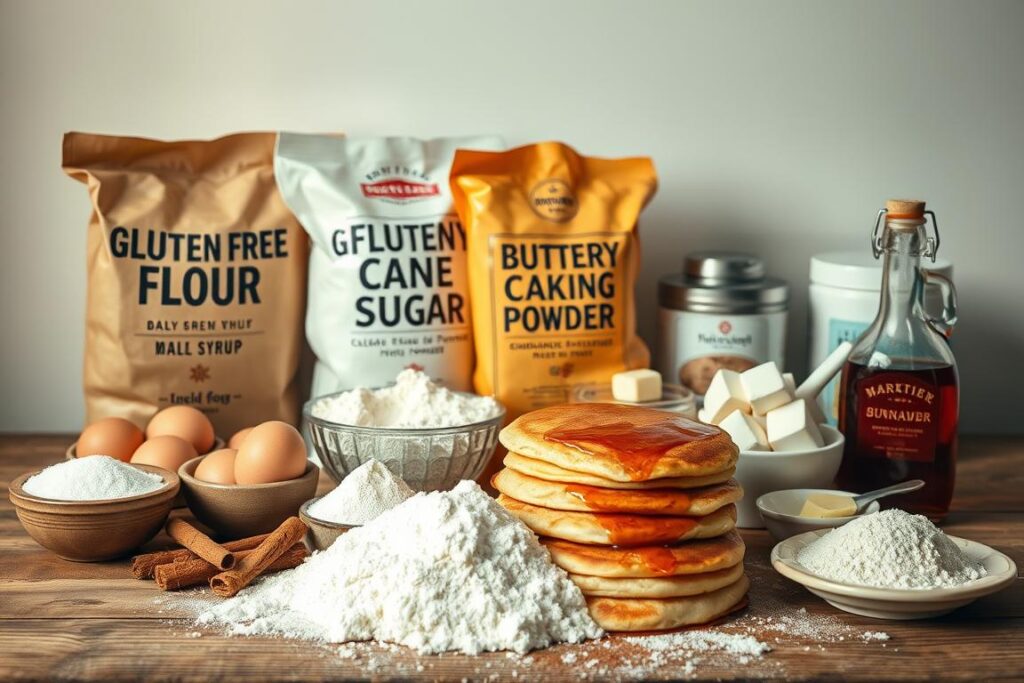
For wet ingredients, eggs and milk are essential. If you’re dairy-free, almond or oat milk works just as well. Butter or its alternatives add richness, while granulated sugar and vanilla extract bring a touch of sweetness and flavor. Don’t forget a pinch of salt to balance the taste.
Accurate measuring is key. Use the spoon-and-level method for dry ingredients to ensure consistency. If you’re short on time, consider pre-mixing your dry ingredients and storing them in a sealed container. This makes weekday mornings a breeze.
By gathering quality ingredients, you’re setting the foundation for a perfect breakfast. Whether you’re cooking for one or a crowd, these staples will make your recipe a success every time.
Simple How-To Guide for Making Gluten Free Pancakes
Mastering the art of a perfect breakfast begins with a simple yet precise process. Whether you’re a beginner or a seasoned cook, these steps will help you create a stack that’s fluffy, golden brown, and delicious.
Mixing the Gluten Free Pancake Batter for Optimal Texture
Start by whisking together the wet ingredients in a large bowl. Combine eggs, sugar, vanilla extract, and oil until smooth. This ensures a rich and cohesive base for your batter.
Next, add the dry ingredients gradually. Sift the flour blend and baking powder into the wet mixture to avoid lumps. Stir gently until just combined. Overmixing can lead to dense results.
For a smooth consistency, pour in the milk slowly while stirring. Adjust the amount to achieve your desired thickness. Let the batter rest for a few minutes to improve texture.
Step-by-Step Cooking Tips for Perfect Gluten Free Pancakes on the Griddle
Preheat your griddle or skillet over medium heat. Lightly grease the surface with butter or oil to prevent sticking. A properly heated griddle ensures even cooking.
Use a 1/4 cup measure to portion the batter onto the griddle. This creates uniform pancakes that cook evenly. Wait until bubbles form on the surface and the edges set before flipping.
Cook the second side until it’s golden brown. Adjust the heat if needed to avoid burning. For troubleshooting, if your pancakes aren’t puffing up, check the freshness of your baking powder.
Serve warm with your favorite toppings. Whether it’s maple syrup, fresh fruit, or chocolate chips, these tips guarantee a breakfast worth savoring.
Adapting Classic Pancake Recipes to Gluten Free Variations
Transforming traditional recipes into modern favorites is easier than you think. With a few simple swaps, you can enjoy your favorite morning meals without compromising on taste or texture. Let’s explore how to adapt classic recipes to fit your dietary needs.
Start by replacing wheat flour with a gluten-free blend. A mix of rice, almond, or oat flour works best to mimic the structure of traditional batter. Adjust the ratios slightly to ensure your stack stays fluffy and light. For example, using a bit more baking powder can help achieve that perfect rise.
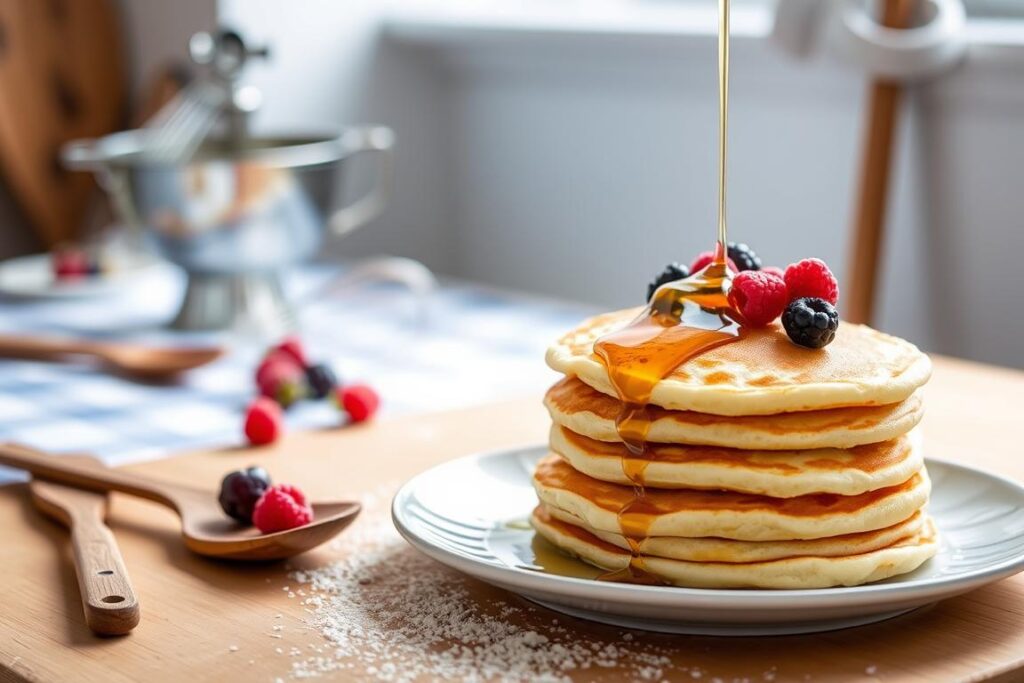
Small tweaks can make a big difference. Letting the batter rest for a few minutes allows the ingredients to hydrate fully, improving texture. When cooking, use a preheated griddle and flip your stack when bubbles form on the surface. This technique, popularized on TikTok, ensures even cooking and a golden brown finish.
Measured ingredients are key to consistency. Avoid guessing by using a kitchen scale or measuring cups. Test smaller batches first to fine-tune your recipe before scaling up for larger gatherings. For example, a traditional Betty Crocker recipe can be adapted by substituting the flour and adjusting the liquid ratios slightly.
Adapting recipes is a creative process. Gradually introduce new techniques, like adding a pinch of xanthan gum for elasticity or experimenting with dairy-free milk alternatives. These small changes can elevate your breakfast game while keeping it familiar and delicious.
Dairy-Free and Egg-Free Gluten Free Pancake Variations
Dietary restrictions don’t have to limit your morning meal choices. With a few simple swaps, you can create a stack that’s just as fluffy and satisfying as the classic version. Whether you’re avoiding dairy, eggs, or both, these variations ensure everyone can enjoy a delicious breakfast.
Dairy-Free Milk and Butter Alternatives
Replacing dairy is easier than you might think. Almond, cashew, and coconut milk are excellent substitutes that add richness to your batter. Each option brings a unique flavor profile, so choose based on your preference. For example, almond milk offers a mild nuttiness, while coconut milk adds a subtle sweetness.
When it comes to butter, alternatives like coconut oil or Earth Balance work seamlessly. These fats provide the same richness and help achieve that golden brown finish. Just make sure to measure them accurately to maintain the right consistency.
Egg-Free Options and Their Effects on Texture
Eggs play a crucial role in structure, but they’re not irreplaceable. Products like Bob’s Red Mill egg replacer or flaxseed mixtures can mimic their binding properties. These alternatives work well, though they may slightly alter the texture.
For example, egg-free batters can sometimes feel denser or gummier. To counteract this, let the batter rest for a few minutes before cooking. This allows the ingredients to hydrate fully, improving the final texture.
With these swaps, you can create a stack that’s inclusive and delicious. Whether you’re experimenting with almond milk or flaxseed, these variations prove that dietary restrictions don’t mean sacrificing flavor.
Perfecting the Pancake Texture
Achieving the ideal texture for your morning meal requires a bit of patience and technique. The right approach ensures your stack is smooth, fluffy, and free from any unwanted grittiness. Let’s dive into the steps that make all the difference.
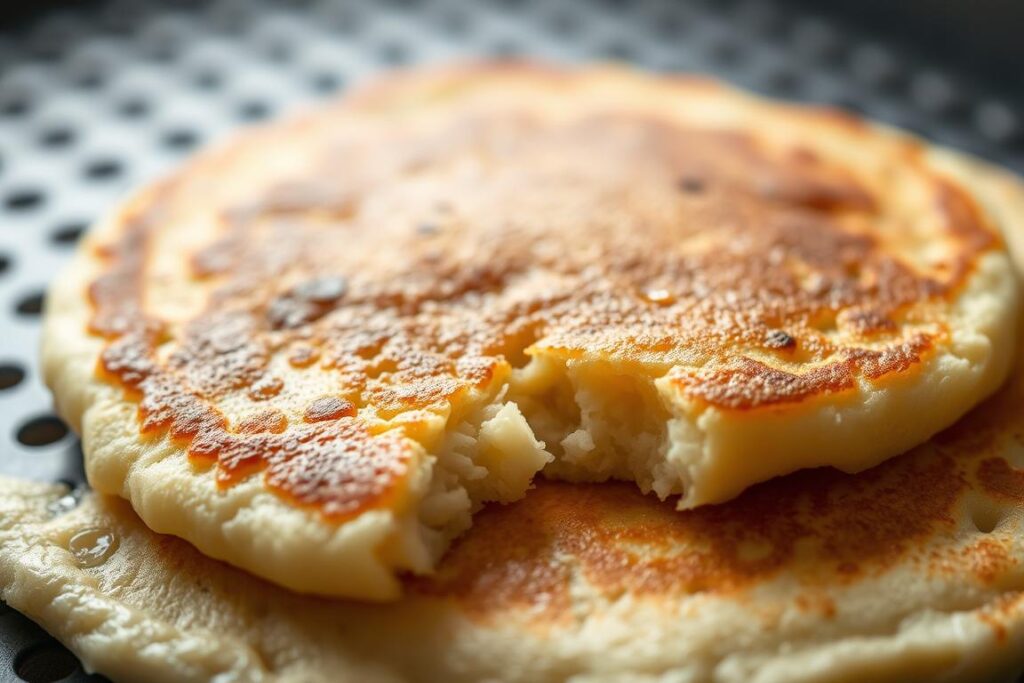
Importance of Resting the Batter
Resting your batter is a game-changer. When you let it sit for 5-10 minutes, the ingredients have time to hydrate fully. This process improves moisture absorption, resulting in a smoother consistency. Skipping this step can lead to a gritty or uneven texture.
Patience is key. Use a timer to ensure you don’t leave the batter standing too long. Over-resting can cause the mixture to thicken excessively, making it harder to cook evenly. A short rest is all you need for perfect results.
How to Avoid Gritty Results
Grittiness often stems from improper mixing or insufficient hydration. Start by sifting your dry ingredients to break up any clumps. When combining wet and dry components, stir gently until just mixed. Overworking the batter can lead to a dense or uneven texture.
Test a small batch first. This allows you to adjust the consistency before cooking the entire mixture. If the texture isn’t right, add a splash of milk or let the batter rest a bit longer. These small tweaks can make a big difference.
- Let the batter rest for 5-10 minutes to improve hydration.
- Sift dry ingredients to prevent clumps and grittiness.
- Mix gently to avoid overworking the batter.
- Test a small batch to ensure the texture meets your expectations.
Understanding these techniques ensures your breakfast is consistently smooth and satisfying. With a little extra care, you’ll master the art of perfect texture every time.
Innovative Mix-In and Topping Ideas
Elevate your breakfast game with creative mix-ins and toppings that transform every bite. Whether you prefer sweet or savory, these ideas will inspire you to customize your stack for a truly unique experience.
Fruit, Nut, and Chocolate Chip Additions
Mix-ins are a simple way to add flavor and texture. Classic options like blueberries or chocolate chips are always a hit. For a tropical twist, try diced mango or shredded coconut. Nuts like pecans or almonds add a satisfying crunch.
Fruits like banana slices or strawberries bring natural sweetness. Mix them directly into the batter for even distribution. This ensures every bite is packed with flavor.
Creative Toppings for Extra Flavor
Toppings can take your breakfast to the next level. Drizzle maple syrup or homemade butter-pecan syrup for a rich finish. Whipped cream and fresh berries create a decadent treat.
For a savory twist, try crispy bacon or a sprinkle of cheese. Granola adds a delightful crunch, while a dusting of cinnamon or powdered sugar offers a subtle sweetness. Experiment with combinations to find your favorite.
Balancing flavors is key. Pair sweet toppings with tangy fruits or add a pinch of salt to enhance sweetness. The right topping can complement the light, fluffy texture of your stack perfectly.
Using an Electric Griddle and Cast Iron Skillet
Choosing the right cooking surface can make or break your breakfast. Whether you prefer the convenience of an electric griddle or the classic charm of a cast iron skillet, each has its unique benefits. Understanding how to use these tools effectively ensures a golden brown finish every time.
Temperature Control for a Golden Brown Finish
Proper temperature control is key to achieving the perfect texture. For an electric griddle, set it to 350-375°F for even cooking. This range prevents burning while ensuring a crisp exterior. Cast iron skillets, on the other hand, require preheating over medium heat for about 5 minutes. Their heat retention properties make them ideal for consistent browning.
Test the surface by sprinkling a few drops of water. If they sizzle and evaporate quickly, it’s ready. Avoid overheating, as it can lead to uneven results. A well-preheated surface ensures your batter cooks evenly and develops that desirable golden hue.
Benefits of Different Cooking Surfaces
Electric griddles offer convenience and even heat distribution. Their large surface area allows you to cook multiple servings at once, making them perfect for family breakfasts. Cast iron skillets, known for their durability, excel in heat retention. This ensures your stack stays warm longer and cooks evenly.
Here’s a quick comparison:
- Electric Griddle: Easy to clean, adjustable temperature, and spacious.
- Cast Iron Skillet: Excellent heat retention, versatile, and adds a rustic flavor.
Properly greasing your surface is essential. Use butter or oil to prevent sticking and enhance flavor. For cast iron, a light coating is enough, while electric griddles may require a bit more. Experiment with both methods to find your favorite.
User experiences from dinerTok highlight the importance of flipping techniques. Wait until bubbles form on the surface before flipping. This ensures your stack is cooked through and achieves that perfect golden brown finish.
Storing and Freezing Your Gluten Free Pancakes
Planning ahead can make your mornings smoother and more enjoyable. By storing or freezing your homemade treats, you’ll always have a quick and tasty option ready. Proper techniques ensure they stay fresh and maintain their light, fluffy texture.
Flash Freezing Techniques
Flash freezing is a simple way to prevent your pancakes from sticking together. Start by letting them cool completely on a wire rack. This step ensures they don’t become soggy.
Next, place them in a single layer on a parchment-lined baking sheet. Freeze for about 10 minutes until they’re firm. Once frozen, transfer them to a freezer-safe container or bag. This method keeps them separate and easy to grab individually.
Best Practices for Long-Term Storage
For long-term storage, use airtight containers or resealable bags. Label each batch with the date to keep track of freshness. Properly stored, they can last up to 2-3 months in the freezer.
When reheating, avoid the microwave’s full power. Instead, use 50% power or a toaster oven for even warming. This prevents sogginess and maintains their golden brown finish.
Here are some additional tips:
- Stack pancakes with parchment paper between layers to prevent sticking.
- Leave a bit of space in the container to avoid crushing them.
- Prepare extra batches during weekends to save time on busy mornings.
With these techniques, you’ll always have a delicious breakfast ready to go. Proper storage ensures your pancakes stay fresh and flavorful, making mornings a breeze.
Nutritional Profile of Gluten Free Pancakes
Understanding the nutritional value of your breakfast can help you make informed choices. Whether you’re tracking calories or focusing on macronutrients, knowing what’s in your stack is key to a balanced meal.
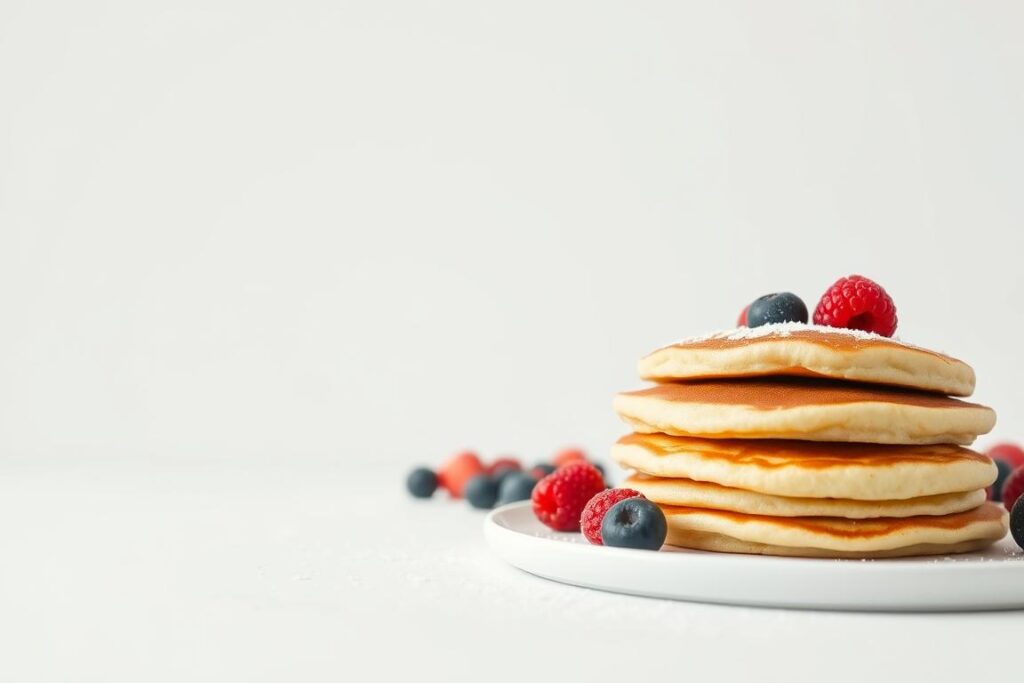
Caloric and Macronutrient Breakdown
A typical serving of these breakfast treats contains around 151-153 calories. Here’s a quick breakdown of the macronutrients:
- Carbohydrates: 20-22g, providing energy for your day.
- Protein: 4-5g, helping to keep you full longer.
- Fat: 6-7g, adding richness and flavor.
These values can vary based on the ingredients used. For example, adding chocolate chips or maple syrup will increase the calorie count.
Understanding Serving Sizes
One serving usually consists of 2-3 pancakes, depending on their size. This portion provides a satisfying meal without overloading on calories. Comparing this to traditional recipes, the gluten-free version often has fewer carbs and slightly more protein.
Here’s how they stack up:
- Traditional: Higher in carbs, lower in protein.
- Gluten-free: Balanced macronutrients, often with added fiber.
Customizing your recipe can further enhance its nutritional profile. For example, using almond flour increases healthy fats, while adding fruit boosts vitamins and fiber.
Portion control is essential for a balanced breakfast. Pair your stack with protein-rich sides like eggs or yogurt to create a well-rounded meal. By understanding the nutritional content, you can enjoy your breakfast while meeting your dietary goals.
Troubleshooting Common Pancake Issues
Even the best cooks face challenges when making breakfast favorites. Whether your stack turns out flat, dense, or unevenly cooked, a few simple adjustments can make all the difference. Let’s explore common issues and how to fix them for perfect results every time.
Dealing with Flat or Dense Pancakes
Flat or dense results often stem from expired leaveners. Check the freshness of your baking powder or soda. If they’re old, they won’t provide the lift needed for a fluffy texture.
Overmixing the batter can also lead to dense pancakes. Stir until just combined to avoid developing too much gluten. Let the batter rest for a few minutes to allow the ingredients to hydrate fully.
If your stack still lacks height, try adding a bit more baking powder or soda. Test a small batch first to ensure the adjustment works before cooking the entire mixture.
Tips for Achieving Even Browning
Uneven browning is often caused by inconsistent heat. Preheat your griddle or pan to the right temperature before adding the batter. A properly heated surface ensures even cooking and a golden brown finish.
Use a light coating of butter or oil to prevent sticking. Too much fat can cause uneven browning, so apply it sparingly. Flip your pancakes when bubbles form on the surface and the edges set.
If one side cooks faster than the other, adjust the heat slightly. A lower temperature can help achieve consistent results. Test one pancake first to gauge the heat before cooking the full batch.
Gluten Free Pancakes: Tips and Tricks
Perfecting your breakfast routine starts with mastering a few essential techniques. Whether you’re a beginner or a seasoned cook, these insider strategies will help you create a stack that’s fluffy, golden brown, and delicious every time.
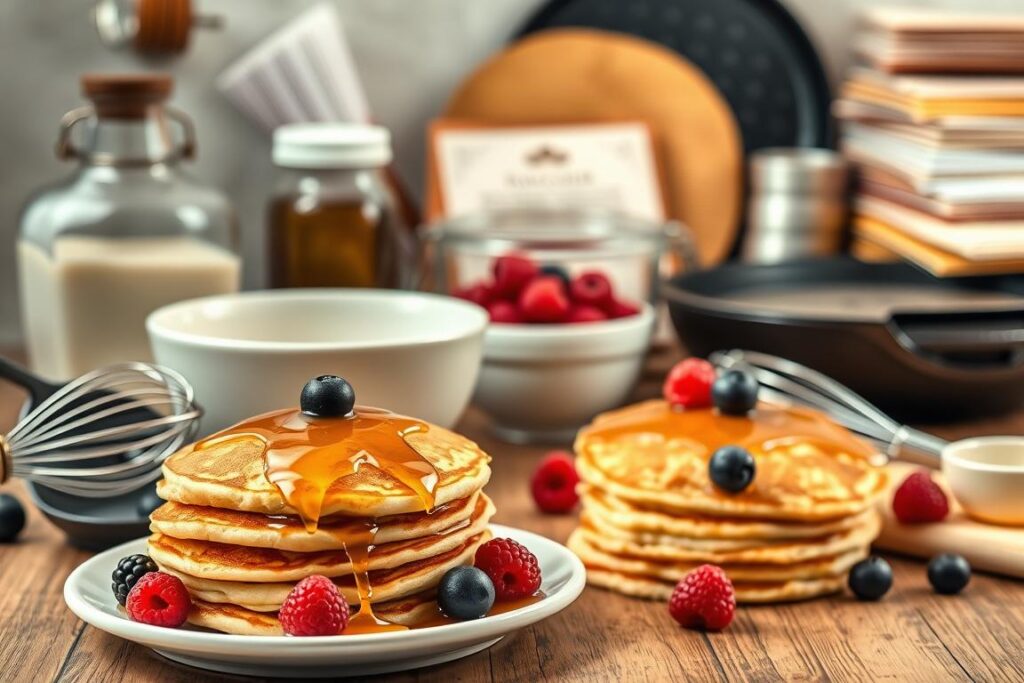
Start by preheating your griddle to the right temperature. A properly heated surface ensures even cooking and prevents sticking. Test it by sprinkling a few drops of water—if they sizzle and evaporate quickly, it’s ready.
Mixing the batter correctly is crucial. Combine wet and dry ingredients gently until just mixed. Overmixing can lead to dense results. Let the batter rest for 5-10 minutes to improve texture and hydration.
For busy mornings, consider making extra batches and freezing them. Flash freeze individual pancakes on a baking sheet before transferring them to a container. Reheat in a toaster oven for a quick and satisfying meal.
Experiment with mix-ins to add variety. Fresh fruit, nuts, or chocolate chips can transform your stack into a unique treat. Balance flavors by pairing sweet toppings with tangy fruits or a pinch of salt.
Here’s a quick reference table for troubleshooting common issues:
| Issue | Solution |
|---|---|
| Flat or dense pancakes | Check baking powder freshness, avoid overmixing |
| Uneven browning | Preheat griddle properly, adjust heat as needed |
| Gritty texture | Sift dry ingredients, let batter rest |
Small adjustments can lead to significant improvements. With these tips, you’ll master the art of creating a perfect breakfast that’s both delicious and satisfying.
Serving Suggestions for a Delicious Breakfast
Make Your Pancakes Visually Appealing
Transform your morning meal into a feast with creative serving ideas. The way you present your breakfast can make it even more enjoyable. Start by stacking your pancakes high for a visually appealing plate. This simple technique adds height and makes the meal look more inviting.
Classic Toppings for a Sweet Touch
Top your stack with a pat of butter and a generous drizzle of pure maple syrup. Fresh berries or a sprinkle of powdered sugar can add a touch of sweetness and color. For a more indulgent treat, try adding a dollop of whipped cream or a handful of chocolate chips.
Pairing Pancakes with the Perfect Sides
Pair your pancakes with sides like scrambled eggs or crispy bacon for a balanced meal. Fresh fruit, such as banana slices or strawberries, complements the flavors perfectly. These combinations create a satisfying and well-rounded breakfast.
Savory Pancake Toppings for a Unique Twist
If you prefer a savory twist, try adding crispy bacon, shredded cheese, or a fried egg on top. These toppings give your pancakes a hearty and flavorful variation, making them a great option for those who enjoy a less sweet breakfast.
Pancakes for Dinner – A Fun Alternative
Breakfast for dinner can be a delightful change. Serve your pancakes alongside hash browns or a fresh salad for a well-balanced meal. This is a great way to bring variety to your dinner routine and make family meals more enjoyable.
Keeping Pancakes Warm for the Best Experience
To keep your pancakes warm until serving, place them in a preheated oven at 200°F and cover them with foil to retain moisture. This ensures that every bite is warm and fluffy, even if you are cooking in batches.
Presentation Tips to Elevate Your Breakfast
A beautiful presentation can make your breakfast even more enjoyable. Here are some simple tips:
- Use a large plate to give your pancake stack room to stand out.
- Garnish with fresh mint leaves or edible flowers for a pop of color.
- Drizzle syrup in a zigzag pattern for an elegant touch.
Small details can enhance the entire dining experience. Whether you’re enjoying breakfast at a cozy kitchen table or on a sunny patio, these ideas will help you create a meal that looks as good as it tastes.
Conclusion
Creating a memorable breakfast experience is easier than you think. This guide has walked you through essential ingredients, techniques, and creative adaptations to make your mornings special. From choosing the right flour blend to mastering the perfect flip on a griddle, every step is designed for success.
Experiment with mix-ins like fresh fruit or chocolate chips to add variety. Don’t forget to try alternative ingredients for dietary needs. Proper planning, from ingredient selection to storage, ensures you always have a quick and satisfying option ready.
Thank you for exploring these tips and tricks. We’d love to hear about your modifications or feedback. Share your creations and connect with us for more recipe ideas. Remember, every great breakfast starts with good preparation—so get cooking and enjoy!
FAQ
What is the best flour blend for gluten-free pancakes?
A mix of rice flour, almond flour, and tapioca starch works well. It provides a light texture and mimics traditional flour. Experiment with blends to find your favorite.
Why is xanthan gum important in the batter?
Xanthan gum acts as a binder, replacing the elasticity that gluten provides. It helps hold the batter together and prevents crumbly results.
Can I make these pancakes dairy-free?
Yes! Use almond milk, oat milk, or coconut milk as substitutes. For butter, try coconut oil or a plant-based alternative.
How do I prevent gritty pancakes?
Let the batter rest for 5-10 minutes before cooking. This allows the flour to fully hydrate, resulting in a smoother texture.
What’s the ideal griddle temperature for golden brown pancakes?
Set your griddle to medium heat (around 350°F). Too hot, and they’ll burn; too low, and they won’t brown evenly.
Can I freeze leftover pancakes?
Absolutely! Flash freeze them on a baking sheet, then store in an airtight container. Reheat in a toaster or oven for best results.
What are some creative topping ideas?
Try fresh berries, sliced bananas, chocolate chips, or a drizzle of maple syrup. For a savory twist, add avocado or a sprinkle of nuts.
How do I fix flat or dense pancakes?
Ensure your baking powder is fresh and avoid overmixing the batter. Gentle folding keeps the batter airy and light.
Can I make these without eggs?
Yes! Use flax eggs, mashed bananas, or applesauce as egg replacements. These options work well for binding the batter.
How do I store pancake batter for later use?
Store it in an airtight container in the fridge for up to 24 hours. Stir gently before cooking to recombine ingredients.


